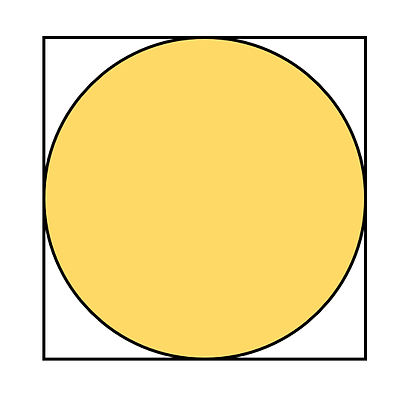Circles and Pi
Learners will have already worked with area and perimeter of shapes that are mostly rectangular, triangular or involving a combination of the two. At secondary level learners will be introduced to problems that involve circles and for this they need to be aware of the special number Pi.
Circumference
Learners will require practice solving problems of increasing complexity using Pi. To begin with they will solve straightforward problems focusing only on normal circles in a variety of contexts after which they may move on to circular-like shapes that involve both curves and straight lines.
Area of a circle
Learners would already have an understanding of area and will have been introduced to calculating the area of rectangles and triangles before addressing circles. However, there is no requirement for them to understand the concept of Pi before starting to find estimates of the areas of circles.

Consider a circle and the square that neatly fits around it.
What fraction of the square is taken up by the circle?
It's something that can be explored by learners but it can be established that the area of the circle is just a bit more than three-quarters of the square.
NB: The circumference is also a little bit more than 3/4 of the perimeter of the square (see the section above), but I would introduce these two concepts separately.
So, if we know some measurements we can start to calculate estimates for the area of the circle.
It's first worth reminding ourselves that the diameter is the name we give for the measure that goes right across the circle through the centre.
This is also the same measurement for each side of the square that surrounds the circle.


To find an estimate of this circle that has a diameter of 10 cm, we can find the area of the square....
e.g. 10 x 10 = 100 cm squares
Then the area of the circle is roughly 3/4 of this or
~75 cm squares
Since we are finding 3/4 of the square it is also useful to consider the circle and square cut up into quarters.
Learners will need to know that the measurement from the centre of the circle to its edge is known as the radius.
And that the diameter is equal to two of these.
NB: The plural of radius is radii (say: ray-dee-eye)


It's worth ensuring the learner is comfortable with which measurements in the diagram are equal to a radius and which are equal to the diameter.
The area of each quarter of the large square is then equal to ...
(radius x radius)
or
1/4 of (diameter x diameter)
Now, we can calculate an estimate for the area if we know the value of the radius.
So, for this example. The area of the circle is roughly equal to THREE quarters of the square.
One quarter of the square is 7 x 7 = 49 cm squares.
The circle's area is roughly 3 x 49 = 147 cm squares
Now, additional problems can be practiced BUT it is also worth discussing the nature of the answers in relation to the approximation!

Using Pi
It's worth watching the video on introducing Pi at the top of this section. I would recommend addressing the calculation of the circumference before the area so the learner may well be prepared for then introduction of Pi in the calculation of area.
So, instead of finding an approximate answer for the area of a circle using the fact that the area is
a little bit more than THREE-QUARTERS of the surrounding square, we can now find an accurate answer using Pi instead of THREE.
